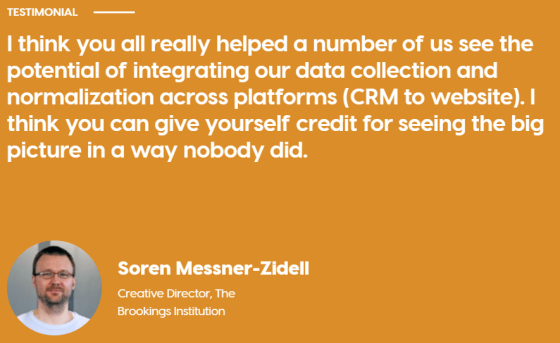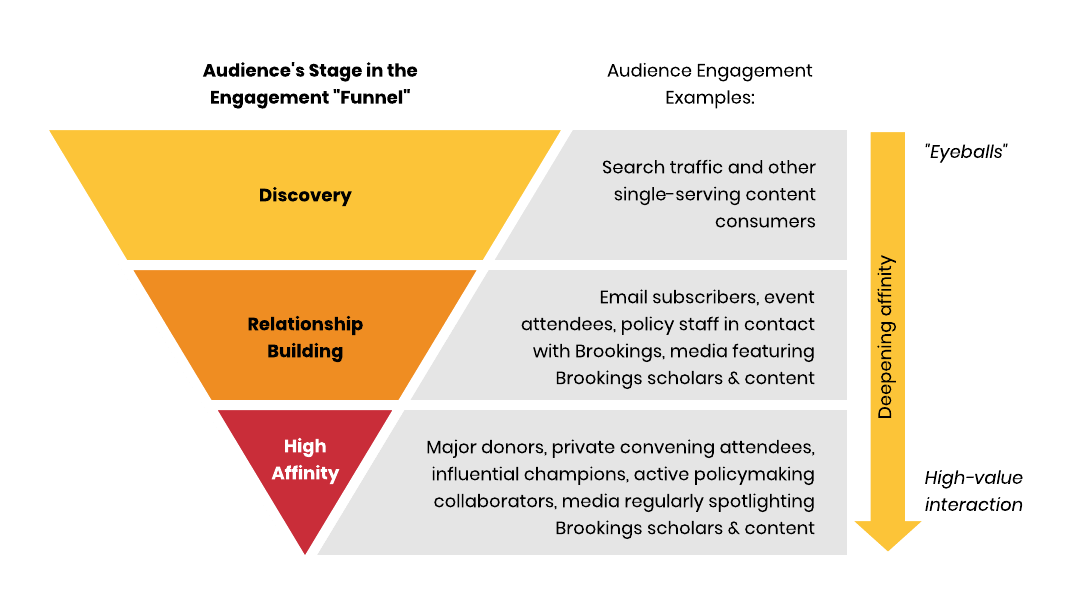The Brookings Institution: Website Redesign Roadmap
A head start for digital advancement
The challenge
Brookings is a large and diverse organization that is constantly evolving: bringing on new experts, conducting cutting edge research & analysis, and adopting new ways to communicate with their audiences. The time had come to revamp their existing website to support recent innovations.
For an organization like Brookings, unlocking the value of their website as a sophisticated outreach tool required collaboration across several program-specific communications teams, and coordinating a high volume of daily content creation for a wide variety of audiences. Brookings is not just generating content either, they are also creating valuable and interesting data that needs to be organized, edited, and curated.
The need to coordinate multiple content creation processes, outreach technology stacks, unique taxonomies, and a high volume of content creation simultaneously, means that their information architecture is complex, multi-faceted, and involves many many stakeholders.
Circumstances that required planning:
- No organization wide taxonomy
Each system had its own categories, issues, and audience definitions that couldn’t be easily mapped or compared across the platform. - Multiple CRMs
Different parts of the organization and different outreach tools each managed their own lists, leading to fragmentation of data throughout digital experiences - Multiple analytics solutions
With many ways to manage and leverage data, it was hard to fully invest time and budget in any one approach to analytics - Differing audience needs
The website must serve a diverse set of audiences across academia, government, the press, and beyond, each with their own interests and levels of expertise.

What we provided
PTKO helped Brookings develop a shared vision of what its future Engagement Architecture should look like and the shared objectives for a successful redesign. Through a patient, inclusive facilitated process with internal stakeholders, the Brookings team built consensus and buy-in for key concepts impacting design and development implementation, leaving them with a strong foundation for success. This process identified criteria to reduce known blockers for the website redesign, including: review cycles and sign-off authority; taxonomy; program and center positioning within the site structure; technical architecture; and data architecture.
For complex organizations, it’s rare that one vendor brings both the vision and all the necessary expertise to connect and coordinate all parts of your audience experience. To ensure Brookings’ new website contributed to positive audience engagements in many areas, we helped them plan out how to coordinate their data, data visualization, fundraising, contact management specialists and vendors with the web redesign project. Including these other important contributors early in the process, in a planned and coordinated way, ensures that the website development vendor selected is set up for success and can plug their great work into the overall Engagement Architecture.
The redesign planning process laid the groundwork for a public RFP to solicit truly comparable proposals, documenting a clear articulation of organizational needs and requirements. Thus, Brookings was well positioned to identify an ideal implementation partner in terms of capability and cost.
Key solutions on the road to redesign:
- Strategic alignment around defined goals
Staff across departments began to speak the same language around what the site should accomplish, ready to start the redesign with the same grounded expectations - Website project team planning
Identified the implementation skills & vendors needed, and how specialist vendors should coordinate with each other to maximize audience engagement. - RFP preparation
Drafted clear, concise, objective RFP requirements & inputs to help ensure that vendor bids appropriately and thoroughly address organizational needs

How we did it
We helped the Brookings communication team build consensus within the organization, across program, departmental, and executive leadership around the challenges they wanted to address with their existing website, as well the opportunities they hoped to access through redevelopment of their website. This plan identified the open questions and areas of discussion that need time to breath, and multiple sessions with internal stakeholders to build consensus around. We also helped identify the key technological wins that a new platform could achieve and document the best and most powerful aspects of their current solution to preserve. We also helped them develop a roadmap that coordinated the planned advancements and internal initiatives that might need to intersect.
What we provided:
- A roadmap for evolution
Our overarching roadmap provides ongoing strategic direction not just for the website, but all the systems that surround and interact with it, putting every stage of growth into context. - Tactical practical next steps
Our analyses detailed near-term changes Brookings can make to content creation, analytics, and more to prepare the organization for a next version of the website that better serves audiences and stakeholders alike
Collaboration as a deliverable
Our process itself made a difference, as the conversations we led focused stakeholders on the opportunities (rather than the compromises) of redesign




